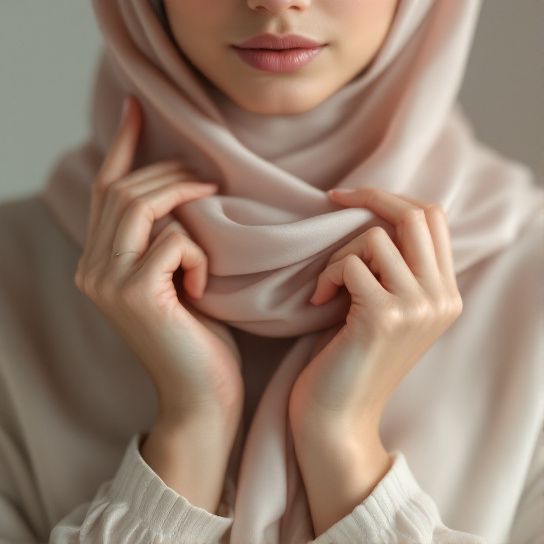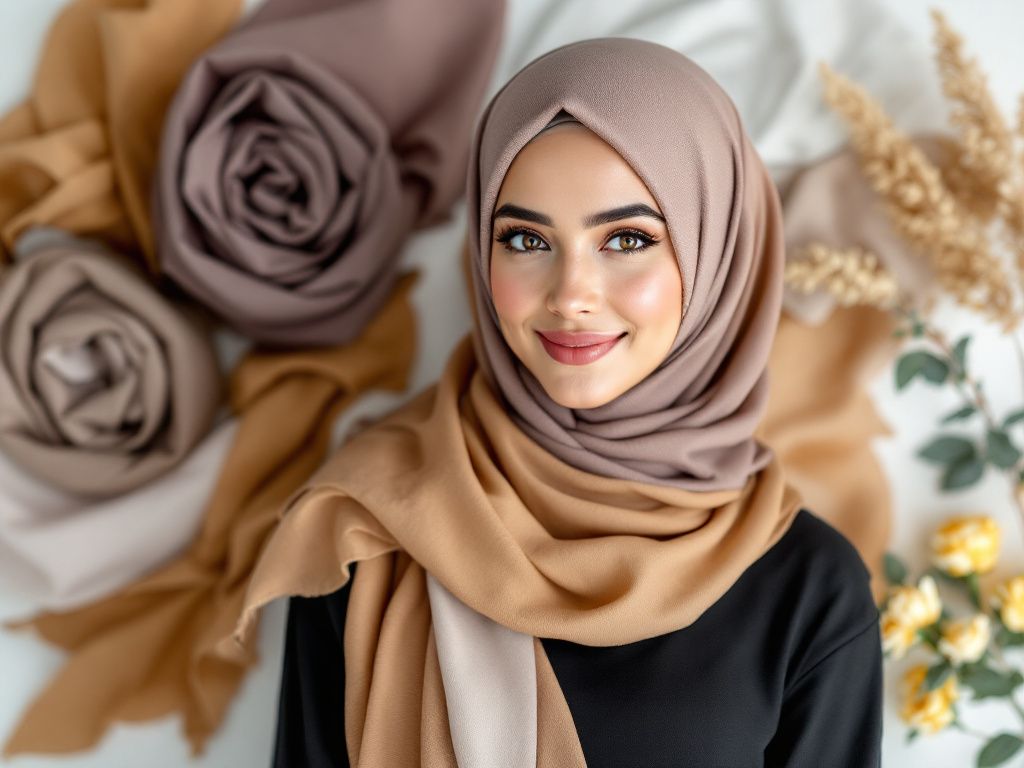Eco-Friendly Hijab Care Guide: A Journey to Sustainable Fashion

Hey there! If you’ve ever looked at your collection of hijabs and wondered how you can take care of them while also taking care of our beautiful planet, you’re in the right place. Balancing personal style with environmental responsibility isn’t always easy, but with eco-friendly practices, it surely can be done. Today, we’re diving into the world of sustainable hijab care—where fashion meets eco-mindfulness.
Why Bother with Sustainable Hijab Care?
First things first: why should you care about eco-friendly hijab maintenance? Well, think of it this way—every piece of your wardrobe is an investment. Not just in terms of money, but also in the change it might bring to our environment. By investing a little extra thought and care into how we maintain daily essentials like hijabs, we can prolong their lifespan and reduce waste.
Choosing the Right Fabrics
Did you know the fabric of your hijab can make a significant difference in how eco-friendly it is? Let’s zero in on a few fabric choices that align well with eco-friendly principles:
- Organic Cotton: A true friend to both you and the planet. It’s grown without harmful chemicals and requires less water compared to traditional cotton.
- Bamboo Viscose: Amazingly soft and naturally antibacterial, bamboo grows quickly and replenishes itself without harmful pesticides.
- Linen: Derived from flax plants, linen is not only durable but also fully biodegradable. Plus, its cultivation is less resource-intensive.
- Recycled Polyester: Though synthetic, when recycled properly, it helps reduce the demand for virgin polyester and avoids plastic waste.
By choosing these fabrics, you’re embracing sustainable hijab care right from the start.
Hand Washing Over Machine Washing
Alright, let’s talk washing. Hands down (pun intended), hand washing is often the better choice when you’re aiming for eco-friendly hijab care. Machines tend to be harsh, tumbling and agitating fabrics more than necessary. A gentle hand wash, on the other hand, utilizes less water and saves energy.

Hand Washing Steps:
- Use Cold Water: This saves energy and is gentler on the fibers, maintaining the color and texture longer.
- Eco-Friendly Soap: Opt for a biodegradable, plant-based detergent that doesn’t include phosphates or synthetic fragrances.
- Gently Agitate: Submerge your hijab and swish it around gently for a couple of minutes. No vigorous scrubbing required.
- Rinse: Use plenty of clear water to make sure no soap residues remain.
- 5. **Press to Remove Water: Don’t wring it out; instead, gently press it against the sink.
Air Drying: Nature’s Choice
Once washed, air drying is your best bet. It’s energy-efficient and kind to fabrics:
- Air/Sun Dry: Hang your hijab away from direct sunlight to prevent fading, and let the gentle breeze do its job.
- Avoid Hangers: If you’re worried about stretching, lay it flat on a towel. That way, you preserve its original shape.
Storing Smartly
Your hijabs deserve a good, eco-friendly storage system too. To keep them looking fresh and new without taking up a lot of space:
- Roll Instead of Fold: Rolling can prevent creases and maximizes space.
- Use Natural Moth Repellents: Lavender sachets or cedar blocks not only smell good but keep these pesky fabric munchers at bay without harsh chemicals.
- Breathable Storage Bags: Consider organic cotton or other natural materials for storage, which allows fabrics to breathe.
Avoid Fast Fashion

It’s easy to get swayed by trends, I know. But the impact of fast fashion can be quite damaging. Instead, aim to invest in high-quality pieces that are built to last. Here’s the deal: you’re looking for all-season staples. These never go out of style and can be paired with almost anything.
Eco-Friendly Hijab Accessories
Just like hijabs, choosing the right accessories can make a difference:
- Eco-Friendly Pins: Stainless steel pins are durable and can be part of your kit for years.
- Natural Materials: When selecting undercaps or bands, choose items made from organic cotton or bamboo for that lovely, light touch.
DIY Hijab Care Solutions
If you’re into a bit of a hands-on approach, creating your own cleaning solutions is a magnificent way to ensure the products coming into contact with your hijabs (and thus your skin) are safe and environmentally friendly.
Simple Homemade Detergent Recipe
- Castile Soap: It’s versatile, so pick an unscented one if you like.
- Baking Soda: It’s a natural deodorizer and safer than bleach.
- Essential Oils: A few drops of lavender or tea tree oil will keep everything smelling fresh.
Combine equal parts of warm water and castile soap, a tablespoon of baking soda, and your chosen essential oils for a clean that won’t let you (or the planet) down.
Circular Fashion Economy

Think about donating hijabs you no longer use or even hosting a hijab swap party. These approaches support a circular fashion economy by keeping items in use as long as possible.
Practical Laundry Tips
- Mesh Bags: Create a small, imperfect yet effective barrier that minimises textile abrasion.
- Wash with Like Fabrics: While this might seem intuitive, it’s easy to overlook during a busy laundry day. Match fabrics to maintain colors and fibers.
- Skip the Softeners: These often contain harsh chemicals; instead, use a vinegar rinse for softness without the guilt.
Reducing Microplastics: A Hidden Peril
For hijabs made from synthetic fibers like polyester, consider a wash bag designed to reduce microplastic release. It’s a simple but powerful step to protect our waterways.
Conscious Consumer Practices
When buying a new hijab, consider researching brands that are committed to sustainability. Look for certifications like GOTS (Global Organic Textile Standard) or OEKO-TEX that assure ethical and green practices.
Wrapping It Up
So, here we are, at the end of our little journey into sustainable hijab care. It’s all about those small, mindful decisions that, when combined, create a positive impact. By selecting the right materials, washing carefully, and storing thoughtfully, you’re doing your bit in kind trend, possible without a doubt, aligning personal choices with a global good.
Remember, going green doesn’t mean sacrificing style. It means uplifting it, embedding it with values we believe in, and weaving a narrative of care—towards ourselves and our environment. Happy eco-friendly caring!
Let me know how these tips work out for you, and if you’ve got any tricks up your sleeve that others might find helpful. After all, we’re all in this together, every step towards sustainability counts!
Frequently Asked Questions
How should I wash my hijab to prevent damage?
It is recommended to hand wash your hijab in cold water using a mild detergent. For machine washing, use a gentle cycle with cold water to prevent shrinkage and color fading. Avoid using hot water and harsh chemicals, as they can damage the fabric and cause colors to fade[2][3][4).
What is the best way to dry my hijab?
Air drying is the safest method to dry your hijabs. Lay the hijab flat on a clean, dry towel, roll up the towel to absorb excess water, and then unroll it to let the hijab air dry flat. Avoid direct sunlight and artificial heat sources to prevent color fading and fabric damage[2][3][4).
How can I remove stains from my hijab?
Act quickly to treat stains. For makeup stains, use a makeup remover or gentle soap and cold water. For food and oil stains, use dish soap. For tougher stains, consider a commercial stain remover that is safe for the fabric of your hijab. Blot the stain gently with tissue paper or blotting paper if you are in a hurry[2][4][5).
How should I store my hijabs to maintain their quality?
Store your hijabs in a way that prevents wrinkles and creases. You can either fold them neatly or hang them on padded hangers. Use breathable fabric bags or dust covers to protect them from dust and sunlight. Organize your collection using dividers or shelves to keep them easily accessible[1][3][4).
References







